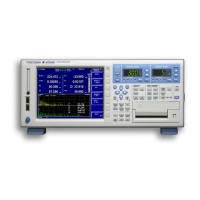I1(1)
I3(1)
I2(1)
φ2(1)
φ1(1),
φU1-I1
φ3(1)
φU1-U3
U1(1)
I1(1)
I3(1)
U3(1)
I2(1)
U2(1)
φU1-U2
φU1-I3
φU1-I2
• Vector Display When the Wiring System Is 3P3W (3V3A) (Three-Voltage, Three-Current)
U1(1), U2(1), and U3(1) are line voltages. I1(1), I2(1), and I3(1) are line currents.
By moving the vectors, U1(1), U2(1),
and U3(1), so that the starting points
of vectors are all at the origin O, the
phase relationship can be observed in
the same fashion as the 3P3W system.
(This instrument does not provide
a function for moving the vectors.)
O
U1(1)
I1(1)
I3(1)
U3(1)
I2(1)
U2(1)
• Vector Display When the Wiring System Is 3P3W (Three-Phase, Three-Wire)
U1(1), U2(1), and U3(1) are line voltages. I1(1), I2(1), and I3(1) are line currents.
However, U3(1) and I3(1) are not actually measured for the 3P3W system.
The vectors are displayed through computation.
O
φ2(1)
φ1(1),
φU1-I1
φ3(1)
φU1-U3
φU1-I2
U1(1)
I1(1)
I3(1)
U3(1)
I2(1)
U2(1)
φU1-U2
φU1-I3
• Vector Display When the Wiring System Is 3P4W (Three-Phase, Four-Wire)
U1(1), U2(1), and U3(1) are common mode voltages. I1(1), I2(1),
and I3(1) are line currents.
U1(1)
U3(1)
U2(1)
φU1-U2
φU2-U3
φU3-U1
The phase difference between the line voltages
can be determined from the phase difference
measurement functions φU1-U2 and φU1-U3.
φU1-U2 = This is the measurement function φU1-U2.
φU2-U3= (φU1-U3) – (φU1-U2) – 180
φU3-U1= –(φU1-U3)

